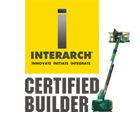Minimum EHS requirements before entering the site
At Interarch, we believe that good safety performance is an integral part of our business and we promise to take foremost account of the health and safety of our employees and erectors. We keep a safe environment while keeping maximum efficiency in all our operational areas.
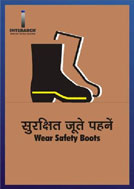
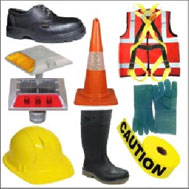
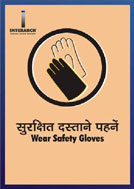
Safety Helmet (BIS CODE 2925)
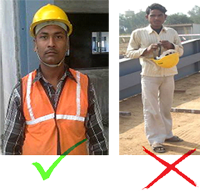
- Safety Helmet safeguards users from the impact of falling or flying objects, risk of head bumping, hair entanglement etc
- Always wear the helmet correctly, do not wear them back to front as it will not give proper protection
- Always keep extra supply of helmets for visitors at site
- Regular Maintenance checks of helmets should be there for signs of damage or deterioration.
- Chin Straps to be fasten always
- Never use your helmet as a handy basket; it is for your Safety
- Do not paint it or use solvents for sticking labels to it, or scratch an identification mark onto it, the shell could weaken and deteriorate easily
- Safety Helmets should be stored away from direct sunlight & heat, as it can deteriorate the plastic
- Never modify, cut or drill your Helmet
Reflective Jackets
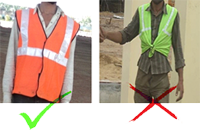
- Reflective safety Jackets increases the visibility of the wearer during poor lightening
- They also help in identifying a person from a long distance
- All Clothing should snugly fit the worker
Safety Shoes (BIS CODE 15298)
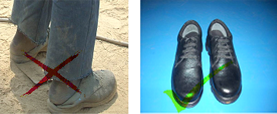
- Safety Shoes safeguards users from wet, electrostatic build-up, slipping, cuts and punctures, falling & rolling objects, metal and chemical splash, abrasion etc.
- Always wear socks with shoes
- Appropriate shoes must be chosen as per the user comfort
- Always clean & polish your shoes in order to protect the shoe from deterioration
- Allow wet boots to dry out thoroughly before wearing again in order to prevent mildew & fungus to develop
- One should immediately replace shoes when
- If there's evidence of physical damage to the toe area or the shoe.
- If shoes are tattered and worn or the toes are poking through the sides or the steel toe is visible through the leather.
- If the sole has cuts, cracks or punctures
Check points of minimum safety requirement:
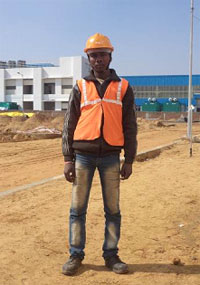
- Only Physically fit employees should be allowed to enter the site
- An individual must wear Safety Helmet
- An individual must wear reflective racket with clothes snugly fit
- An individual must wear Safety Shoes
- All Personal protective equipment (PPE) should be stored in a clean and fully operational manner.
- PPE needs to be checked regularly both during storage and use
- It should be easily accessible when needed
- Damaged/worn-out Safety Shoes, Safety Helmets, Reflective Jackets should be discarded immediately from the site as per the manufacturer instructions
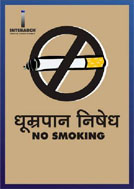
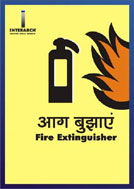
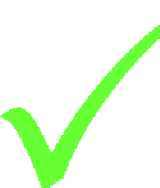
Safety measures to be followed while Loading & Unloading of material:
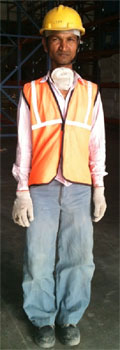
- Access to the trailers should be easy and inspected well in advance to avoid any obstructions such as overhead electric lines etc.
- Trailers should be in good working condition especially the brakes, lights, horns and other warning signals
- Trailer should always be supported by the signal man while unloading material
- Area specific PPE like safety helmet, safety shoes, reflective jackets, snugly fitted clothes etc should be worn while coming out of the vehicle cabin
- For cranes/hydras following certificates are mandatory. The same should be valid as on date.
- Driver License
- Insurance Policy of the vehicle
- RC/ Fitness Certificate
- Pollution certificate
- Load Chart
- TPI Certificate
Safety tips for Loading & Unloading of material
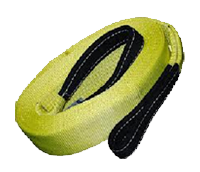
- Only trained and competent person should be permitted to operate cranes
- Display safety signage and freeze the area for any unauthorized entry
- Ensure even and flat base for movement of cranes
- Sling position should be fixed carefully knowing the centre of gravity by trial and error method
- Site Area to be kept tidy at all times
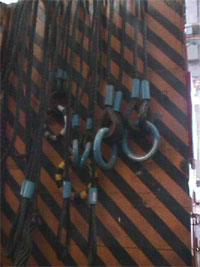
- Ensure built up material like columns, rafters etc should be handled using slings with proper packing
- To avoid damage, the cold form material like purlin, girts & sheets should be handled using polyester/web/nylon slings with proper packing
- Hydra to be used only for material lifting and never for shifting of material
- Avoid jerking while lifting
- Every sling should have a proof load capacity test certificate
- An inspection logbook should be maintained containing sling I.D. number, date in service and safe working load as stated on the proof load certificate
- All slings to be visually examined for damage or defects before and after use
- Slings shall be stored away from extreme heat, moisture andcorrosion
- Any sling found to be defective or damaged shall be immediately removed from service and destroyed to prevent further use and its removal from service shall be recorded in the logbook
- The pins are parts of the shackles, so proper care must be taken to use the correct pin for each shackle
- Rebar, mild steel bolts or similar items should not be accepted
Precaution at site:
- Never disregard the PPE's while unloading the material
- Never guide the lifted load with bare hands
- Never move under the lifted load
- Never use damaged slings, shackles etc
- Check the vehicle for any hydraulic leakage, tyre condition and pressure, windshield or any other condition which might be hazardous at site
Safety requirements before starting the erection activity
- Before the start of lifting operations an authorized person should hold a toolbox talk with all personnel assigned to carry out the lift
- Only trained & competent persons with valid driver’s license should be permitted to operate the cranes and boom lifts
- People involved in lifting operation should be physically fit, skilled, experienced and their responsibilities should be clearly allocated to them
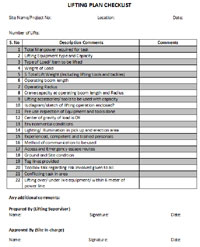
- Area specific Personal Protective Equipment (PPE) should be used by the team while working
- The ground should be properly leveled and compacted before the movement and positioning of cranes or boom lift
- All cranes should be fitted with an appropriate safe working load indicator, over hoist limit switches and hook safety latch etc.
- The supervisor should always inform the slinger and operator about the weight to be lifted
- A detailed lift plan of required radius, boom length, safe working limits of the crane, weight of the load, ground and site conditions, placement of the crane, swing and tail clearances, rigging hardware and type of communication must be maintained at site
- Proper lighting to be maintained for better visibility post sunset and during night
- In poor weather condition all lifting operations must be stopped as they impact the visibility of the lifting crew
- If the crane is to be used within 15 m of overhead lines on steel towers, or 9 m of overhead lines on wood, concrete or steel poles, the local offices of the Electricity Board should be informed and consulted
- In case of an emergency
- Call for help and seek assistance from a co-worker
- Use the emergency telephone numbers and instructions posted in the work area to request assistance and transportation to the local hospital
- Emergency contact numbers such as medical center, first aid help, project head, safety in charge, fire station, security, fire station, local police station, and safety signage’s must be displayed on the notice board at site
- Once the lifting operation is complete it must be reviewed, any improvements or feedback suggested must be recorded, and appropriate action should be taken









